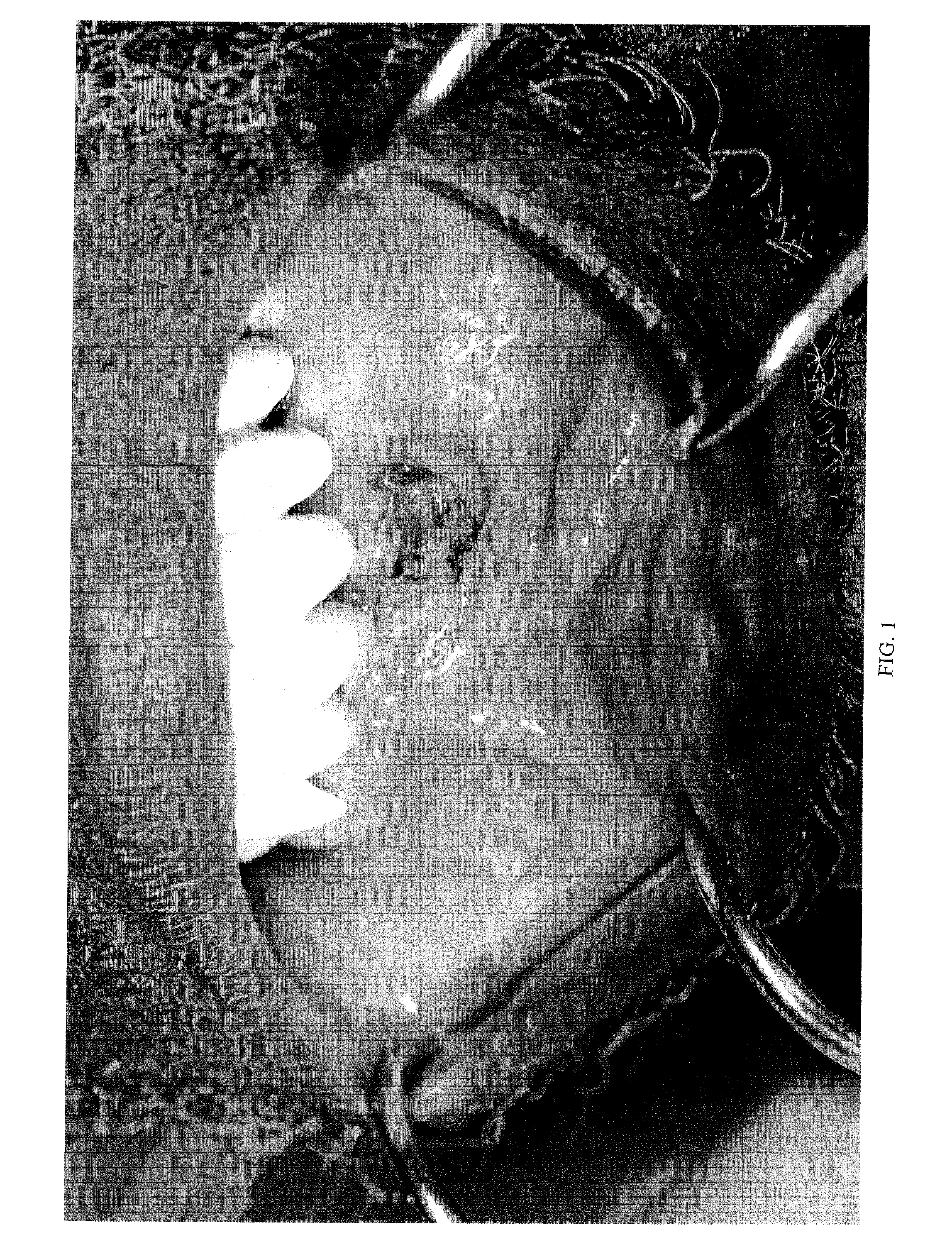Methods and kits for detecting risk factors for development of jaw osteonecrosis and methods of treatment thereof
a risk factor and osteonecrosis technology, applied in the field of molecular biology, genetics, medicine, can solve the problems of large proportion of the general population (, patients) at risk, and the osteonecrosis to become exposed and fail to heal
- Summary
- Abstract
- Description
- Claims
- Application Information
AI Technical Summary
Benefits of technology
Problems solved by technology
Method used
Image
Examples
example 1
Determination of Allele Frequencies for SNPs
[0067]Methods
[0068]Genomic DNA was isolated from lymphocytes in whole blood using a commercially available kit (Qiagen DNA Blood Isolation Kit, Qiagen, Valencia, Calif.). The isolated DNA samples were quantified by spectrophotometry and agarose gel electrophoresis methods and standardized to 20 ng / ul.
[0069]Genotyping for the two alleles SNPs SNP [A / C], dbSNP ID (rs1800012) (SEQ ID NO:15), COL1A1 gene chromosome 17, and SNP [A / G], dbSNP ID (rs12458117) (SEQ ID NO:1), TNFRSF11A gene chromosome 18 was performed by PCR, and by the fluorescence-based TaqMan® (Applied Biosystems, Foster City, USA) genotyping method (De la Vega et al., Mutat Res. 573(1-2):111-135, 2005).
[0070]TaqMan genotyping assay probes [(C—7477174—30 for SNP [A / C], dbSNP ID (rs1800012) (SEQ ID NO:15), COL1A1 gene chromosome 17, and C—31393804 for SNP [A / G], dbSNP ID (rs12458117) (SEQ ID NO:1), TNFRSF11A gene chromosome 18] were purchased from Applied Biosystems, Foster City, ...
example 2
Genotyping for SNPs
[0076]Genomic DNA was isolated from lymphocytes of blood samples from 50 subjects, 6 cases of BONJ and 45 controls (patients without BONJ) and were genotyped for 4 single nucleotide polymorphisms (SNPs): dbSNP ID (rs1934980 (SEQ ID NO:13), and rs1934951 (SEQ ID NO:14)) from the CYP2C8 gene; dbSNP ID (rs1800012) (SEQ ID NO:15) from the COL1A1 gene, and dbSNP ID (rs12458117) (SEQ ID NO:1), from the TNFRSF11A gene.
Total number of cases and controls genotyped = 48(cases = 6, controls = 42)rs1934980 (SEQ ID NO: 13)SNP A / GCYP2C8 geneA = 82%G = 18%G allele in cases = 2% G allele in controls = 16%rs1934951 (SEQ ID NO: 14)SNP C / TCYP2C8 geneC = 78%T = 22%T allele in cases = 2% T allele in controls = 20%rs1800012 (SEQ ID NO: 15)SNP A / CCOL1A1 geneA = 93%C = 7%C allele in cases = 1% C allele in controls = 6%rs12458117 (SEQ ID NO: 1)SNP G / ATNFRSF11A geneG = 87%A = 13%A allele in cases = 2% A allele in controls = 11%
example 4
Analysis of Candidate Gene SNPs Association with BONJ
[0077]Medical and dental charts at the University of Florida (UF) and the associated Veterans Administration Medical Center (VAMC) were reviewed. As shown in Table 2, 27 patients were identified with BONJ having a median age of 62 years, 19 with myeloma, 3 with prostate cancer, 2 with breast cancer, 2 with head and neck cancers, and one with renal cell carcinoma. There were 21 males. Twelve patients received sequential pamidronate and zoledronate treatments, eleven had zoledronate and 3 had pamidronate. Fourteen patients had modest increases in their serum creatinine concentrations. The average number of previous chemo / radiotherapy regimens was 3.5. Nine patients had Thalidomide, 5 had Bortizomib. Primary disease status was as follows: 12 patients in clinical remission, 5 with stable disease and 10 with progressive disease. Eight patients received statin therapy and 6 had diabetes mellitus. The median length of treatment with BP b...
PUM
| Property | Measurement | Unit |
|---|---|---|
| Fraction | aaaaa | aaaaa |
| Fraction | aaaaa | aaaaa |
| Fraction | aaaaa | aaaaa |
Abstract
Description
Claims
Application Information
 Login to View More
Login to View More - R&D
- Intellectual Property
- Life Sciences
- Materials
- Tech Scout
- Unparalleled Data Quality
- Higher Quality Content
- 60% Fewer Hallucinations
Browse by: Latest US Patents, China's latest patents, Technical Efficacy Thesaurus, Application Domain, Technology Topic, Popular Technical Reports.
© 2025 PatSnap. All rights reserved.Legal|Privacy policy|Modern Slavery Act Transparency Statement|Sitemap|About US| Contact US: help@patsnap.com


